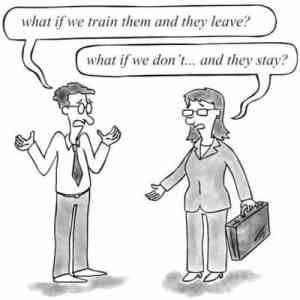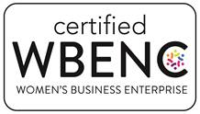I’m going to assume that I’ll receive some guffawing and resistance from the L&D community after this one, but I need to get something off my chest. Unless you have more than 2,500 employees at your organization, the current cost-model to develop in-house learning programs is… silly.
There is an approach to training development that states for 1 hour of traditional, in-person training it takes an average of 38 hours of development. Prior to 2017 this data was even longer. Designers want their provided training to hold VALUE. This custom approach is believed to merit this many development hours and great cost.
I have been a proponent of this choice. I have made this choice. However, now, I am a bit older, and dare I say it, a bit wiser. Creating training in-house at an organization is a bit like herding cats. Creating order from chaos. When we approach our training goals via this dynamic, I understand the need for these hours. However, is this always the tool we should be using?
What is this costing an organization and what are they getting out of it in return?
Before we get into my frustrations resulting from the implications of this data, let’s examine this information and understand what it means:
- In Boston, the average Instructional Designer makes $86,619 a year (Salary only, not full compensation).
- Now let’s take into account this information, that studies show employees are only productive an average of 3-hours a day.
- From there we’ll assume the above instructional designer takes two weeks’ vacation but uses those 3 hours entirely on course development. This would leave us with 750 hours of development time.
- When you use the numbers from the graph below, this designer would be able to create somewhere between 19 – 27 hours of training. A YEAR!
[table id=2 /]
- This doesn’t include facilitating the training, but let’s assume that’s given to someone else to do. I’ll assume this is done by a specialized L&D trainer. The average salary for a Learning and Development Trainer in Boston is $78,679. If we don’t take into account their entire salary and only assume the hourly rate when needed, these costs are minimal to the training and would add on an extra $38 an hour to the program prices below.
So in total said instructional designer would have created the following courses at the following costs to the organization.
[table id=1 /]
Why these costs are so insane to me:
This is 2020, and we are living in a digital world where content is more prevalent than ever before and new content is being created every day (2.5 quintrillion bytes of data in 2018).
If we take the Fortune 2000 companies and assume that each of these organizations has a learning and development department, and assume that many of the problems and needs which these learning teams have, ARE similar in nature, why in the world is each organization re-creating the wheel? How CUSTOMIZED does this training really need to be?
We NEVER look at L&D costs like this. But when we reach out to vendors and find out a 1-hour online course costs $10,000 we wince and say, never mind we’ll create it in-house. Why do I know they would say this? I know this is the case because I was that person wincing. I was that L&D director, deciding we’d do it in-house instead. But here’s the thing. Looking at the data above, said company would have just wasted $7,323 by doing that.
In an ideal world there would be a repository of all different training programs companies have offered at their organizations for people to take and plug and play for their organizations. An open-source learning and development content creator to shrink down the above time-slot. While you can purchase eLearning content from a plethora of vendors (and in many cases you should), I’m keeping in mind that you want to customize the content and that isn’t always the case with many eLearning vendors. So, unless I’m missing something, this open-source content creator doesn’t currently exist.

How can it be done better? And cheaper? And Faster?
Great question. This is where experienced vendors come in. Not jack of all trades vendors but vendors who have specialized their craft and proven expertise in their area of study/training. Vendors that specialize in ONE and ONLY ONE area of expertise. These vendors can cost between $3,500 – $10,000 a day. Using the graph above, said company would be saving anywhere between $24,000 – $31,000 by offering that program. You want to argue that the development price in the graph above can be used over and over? Ok fine. Let’s average out our vendor cost at $5,000 a day. You will break even after that vendor has taught their BEST IN CLASS program 7 times. I’m going to assume your instructional designers’ class is probably pretty good. Maybe even excellent. But BEST IN CLASS? If it is, they should probably be asking for a raise…which in turn would make the graph above even more expensive.
But let’s say you do want to offer that class more than 7 times. Maybe you are a 2,500-employee company are rolling our a 1-day program to all of your managers.
What does this look like for a 2,500-person company?
In a 2,500-person company I’m going to assume each manager has about 8 direct reports, which would mean there would be 313 managers in the company. To ensure you’re getting a good teacher: student ratio let’s have 20 people in each course which would mean we’d need to offer this program 15 times. If you know you will be offering your program 15 times, you are left with two options:
- Wait 5 months for your instructional designer to create the content in-house for $34,647
- Work with the vendor to get a bulk-buying discount (we’ll say 20% for this example) and get the BEST IN CLASS program started in 2 – 3 weeks for $60,000.
More often than not, my recommendation would be to go with option 2. If I learned anything from Steve Kaufer at TripAdvisor it’s that SPEED WINS.
Now I’m not saying we should get rid of every instructional designer and never create in-house content again. Far from it. They are still a necessary commodity. My recommendation would be to utilize SPECIALIZED vendors for a bulk of the important needs and use in-house (or contract) instructional designers for company specific needs. I mean REALLY company specific. Even better – hire a contractor, who has worked with other companies, probably on similar content who might have SOME of the content you’re looking to create already available to plug and play! This designer should be able to get you the content relatively quickly and at a better rate.
Should I have an in-house L&D department at all then?
Depending on the size of your organization, yes. Learning and Development will need to be there to find these vendors to fit your companies needs. They will need to follow-up with employees to ensure the information is retained and push the executives to make the content a part of the company culture as a whole. Formal training is only a small part of an employee’s learning and development. The 70:20:10 model states it’s only 10% of how people learn. Push your L&D team to spend only 10% of their time on the formal training. Give them the rest of the time to spend on the experiential and the social aspects of your employee’s learning experiences. Then get back to me and let me know how your employees are performing. Because at the end of the day, we’re a business and improving performance is the ultimate goal.









